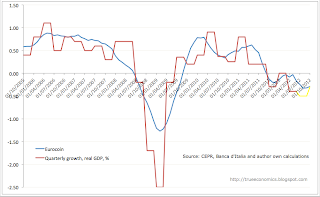European industrial production indices released today show that through June 2011, core Euro area economies have slowed down significantly their industrial and manufacturing output growth. This outcome, well flagged earlier by PMIs and
eurocoin leading indicator of economic activity, implies that in all likelihood, Euro area growth for Q3 2011 is going to show if not an outright contraction, at the very least flat-line performance.
For Ireland (we have data through July now - see PMI data analysis for
manufacturing and
services, plus additional analysis of
exporting activity and
industrial turnover and volumes) this trend is now fully established with either contraction signals remaining persistent over recent months or flat-line trend being established on more volatile industrial production data for some 12 months now.
But what about the rest of the EU and the Euro area? Here is the data.
Industrial production index showed a decline from 101.63 in May to 100.94 in June for the first time since September 2010 (against 2008 average of 106.6, 2009 average of 90.88, 2010 average of 97.66 and 2011 average to-date of 101.18) driven, primarily by:
- Germany index falling from 111.7 in May to 110.8 in June, with current 2011 average to-date standing at 110.37, up on 2010 average of 103.48, 2009 average of 93.46, but below 2008 average of 111.73
- Greece contracting from already recessionary 75.68 in May to 74.02 in June - the worst performance since 1994 when the series began
- Spain posted a decline from 84.97 to 84.26 between May and June this year. This compares poorly against the running average for 2011 to-date of 84.87, 2010 average of 84.68 and 2008 average of 99.55. However, the index is still above 2009 average of 83.97
- France also recorded a decline in industrial activity from 94.80 in may to 93.20 in June with current average for 2011 to-date standing at 93.93, ahead of 2010 level of 91.49 and 2009 level of 86.95, but below 2008 average of 99.40.
- Italy recorded a decline from 90.00 in May to 89.5 in June with current 2011 average to-date remaining ahead of 2009 and 2010 averages, but well below 2008 average of 102.00
- Netherlands, Denmark, Portugal and Finland showed declines in their indices in June
- Ireland and the UK were the two countries in the series to show an increase in the index, while Belgium, Austria and Sweden did not report data for June.
- Poland showed a slowdown in the sector from 143.7 in May to 140.6 in June with current 2011 average to-date standing at 140.77, still significantly up on 2010, 2009 and 2008 averages
- The UK posted a marginal increase in the index from 89.57 in may to 89.58 in June with current 2011 to-date average running at 90.09 - ahead of 2010 average of 89.99 (marginally) and 2009 average of 87.74, but below 2008 average of 97.58.
Charts to illustrate (note: SOEs refers to Small Open Economies):




On Manufacturing side: Denmark, Germany, Greece, Spain, France, Italy, the Netherlands, Poland, Portugal, Finland and the UK all showed declines in output activity. Only Ireland posted a rise in June.

Euro area manufacturing activity overall fell from 102.76 in May to 101.67 in June and is now below 2011 average to-date of 102.32, although still running ahead of the annual averages for 2009 and 2010. 2008 annual average was 107.27, well ahead of the activity levels to-date.
New orders also came in disturbingly lower at 104.64 in June down from 105.74 in May. New orders index now running below its 2011 to-date average of 104.77 and below 2008 average of 110.09, thaough still well-ahead of 2010 and 2009 averages.

Again, as before, new orders fell in Denmark, Germany, Greece, Spain, France, the Netherlands, Poland, Portugal, Finland and the UK. The New Orders sub-index rose in June in Ireland and Italy.
Capital goods production declined significantly in the Euro area from 107.05 in may to 105.5 in June and now stands below 105.55 running 2011 average to-date, ahead of 2009 and 2010 averages, but below 2008 average of 113.52.

In terms of individual countries, capital goods output fell in Denmark, Germany, Ireland, Greece, Spain, France, the Netherlands, Poland and Portugal. Output rose in Italy, Finland and the UK.


















































